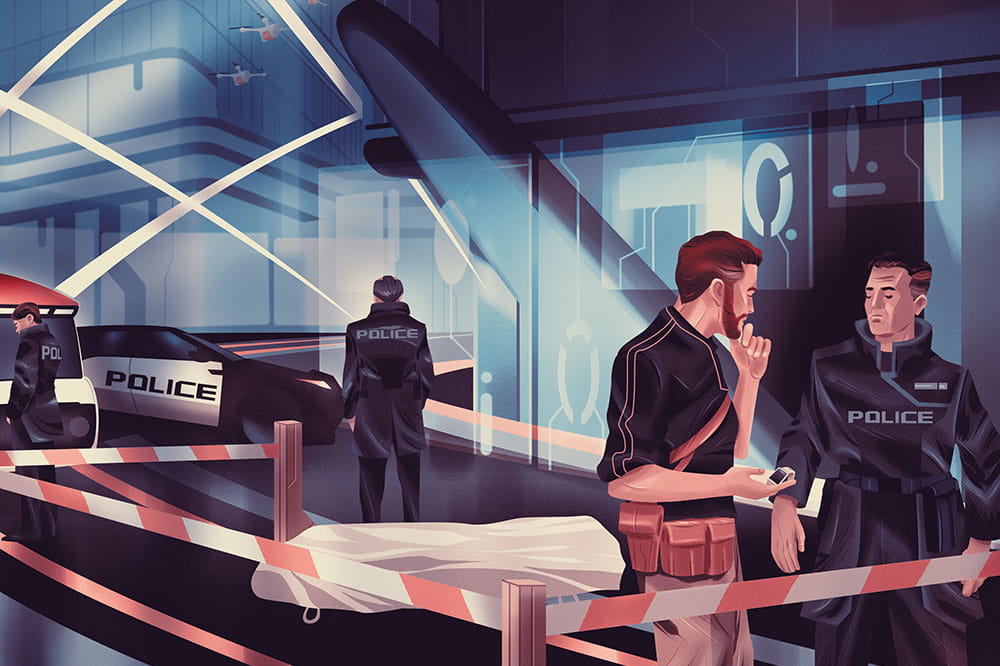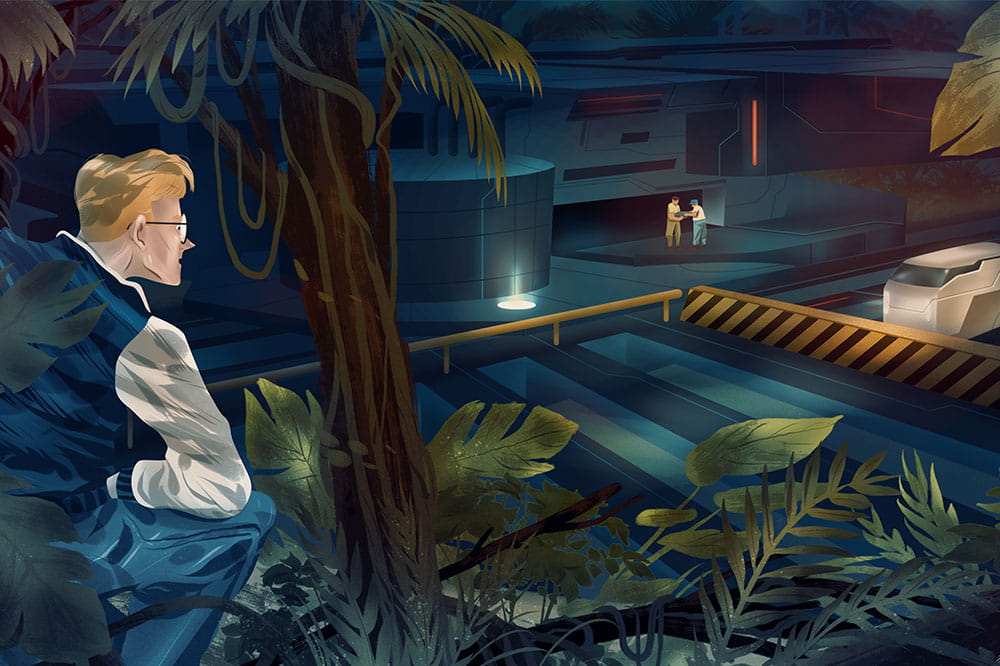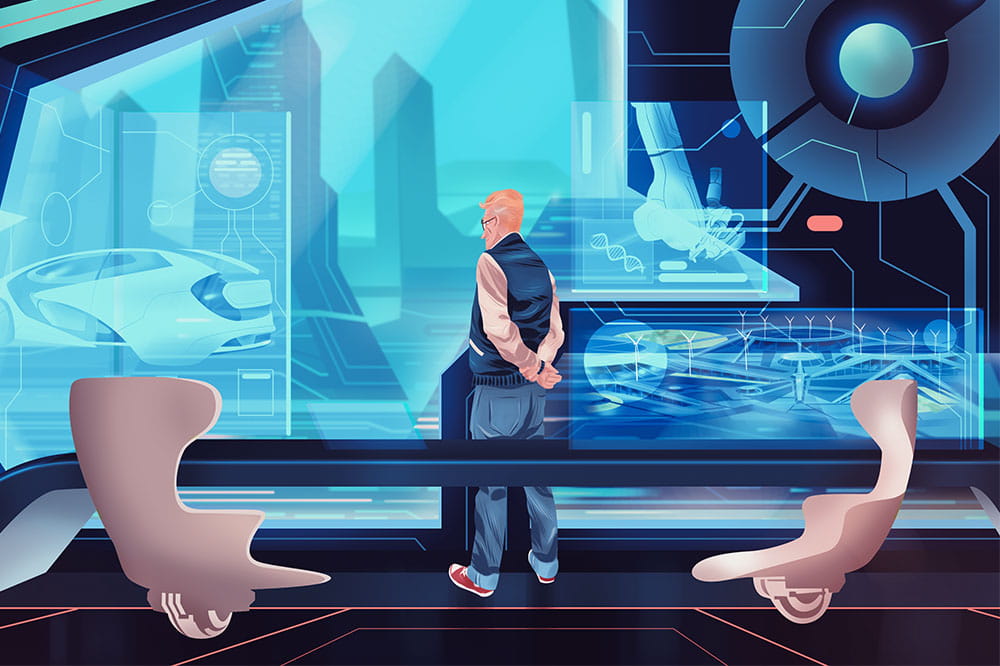Obtain news and background information about sealing technology, get in touch with innovative products – subscribe to the free e-mail newsletter.

TRAVELING INTO THE FUTURE
Each month, you can find a new chapter in the ESSENTIAL science-fiction series “Trip into the Future.” In a fictional world where the goals of the Paris climate accord have become a reality, Nero, a blogger, explores the potential technological and social transformation resulting from it. The goal of the series is to play with fully different visions as creatively as possible and to take the reader along on a thought experiment: What might our future look like – and why is it important to us?
Short Science Fiction Stories: Part 14
All in the Head
“Hi Nero, you should take a look at this,” Avar said. I saw a link to the thought feed of Inspector Lee – a figure who was well-known to me – materializing before me. “Another criminal case?” I asked. “Bigger than that,” Avar answered. “It could mean the end of our reporting trips – and a radical revolution for our zero-emission world.” Surprised, I murmured something and pressed “Play.” My interest was aroused.
“He is dead.” “I see that,” Inspector Lee said, confirming the coroner’s assessment. He was not imaginative enough to conceive how someone could still be alive whose skull was shattered by a marble bust. He looked around Dr. Abelardo’s work room. There were monitors and holographic drawing boards, with a few stacks of paper between them. Abelardo seemed to have had an out-of-date love of paper. “I assume that this didn’t occur when the bust accidentally fell on his head,” Lee said. Keita, the coroner, shook her head. “Someone delivered a powerful blow,” she said, and then pointed at the open safe on the wall. “And that looks like the evidence of a break-in to me.” “Could you please give me an idea of what Dr. Abelardo was working on?” Lee asked his colleague. She wrinkled her brow. “But your AI assistant can do that.” “I don’t have one.” “You are probably the last person in the world who doesn’t have an avatar, Inspector.” “That’s possible. I tried an avatar once. It got on my nerves.” “You can configure it to your personal preferences, Lee,” Keita said. She tapped on her ear, spoke briefly with a personal assistant (whom only she could see) and requested the data set. The holographic text appeared in the air in front of her. The company that employed Abelardo as an innovation manager was known for its groundbreaking ideas. “Bionic scientist,” Lee said, reading from Abelardo’s resume.

The Man with the Revolutionary Visions
“What does a bionic scientist do,” he asked Keita. “You’re not familiar with Dr. Abelardo? He is the guy who revolutionized cooling in homes with capillary stones and made air-conditioning unnecessary, and who discovered the bacteria that consume the plastic trash in the ocean. Bionic scientists get their ideas for innovations from nature. The man was a superstar. For example, Abelardo drew inspiration from termite mounds, which stay cool and… He was only half listening as he scanned Abelardo’s current projects: lightweight construction, inspired by the bones of birds. Spider-web adhesives. Then the cryptic title “Project Lifesaver.” He furrowed his brow. “Additional information,” he instructed the computer. “Project Lifesaver is a thought experiment undertaken by Dr. Abelardo,” the computer voice said. “No other information is stored. Please contact Dr. Abelardo personally.” Unfortunately, that’s not something I can do, Lee thought. He looked at the shattered skull. “Did Dr. Abelardo have an AI assistant?” he asked the coroner. “How should I know?” “You just said I’m the last person in the world who doesn’t have one. If he had one, where was the hardware for it? Could it still be in the remains of his skull?” Keita rubbed her chin, and then said: “It’s possible.” “Do me a favor and look for it. Maybe he talked to his avatar about this mysterious project.” As the coroner began looking for a miniature computer in the shattered head, Inspector Lee poked around in his breast pocket for an anise stick, thrust it into his mouth and began chewing on it.

Disruptive Technologies
“It’s actually right here,” Keita said after a while. “We can try to link the AI assistant to our holographic system. Both of us should then be able to talk to it.” “Let’s try it.” The image of a young man, dressed in a chemist’s lab coat, materialized where the files on Abelardo had been. “Computer assistant, tell me whether Dr. Abelardo spoke with you about Project Lifesaver,” he ordered. “So why exactly are you talking to me?” the voice of the avatar responded. Lee rolled his eyes. “I told you that these AI assistants get on my nerves,” he told Keita. “Please could you possibly help us?” the coroner implored the hologram. “Abelardo was apparently murdered. We are trying to find evidence.” The avatar’s face remained expressionless Lee sighed. “Please…,” he said, starting again reluctantly, but the man in the lab coat raised his hand, “Dr. Abelardo considered the research to be extremely confidential because it dealt with a disruptive technology with the potential to destroy entire industries. He had a few colleagues whose research was financed by companies that could potentially be affected,” the avatar said.
“I hear that you cannot slow technological progress,” Lee said. “My database of world history and technological innovation tells me that people certainly cannot prevent progress. But they can very easily delay it. Think back to the early 2000s and how far away the breakthrough in electric mobility seemed. Or the existence of artificial intelligence like me.” Lee suppressed a comment about the state of “artificial intelligence.” Instead, he said: “Okay, then – so what did this project involve?” “The complete CO2 cycle.” “I don’t understand.”

All in the Head?
“Dr. Abelardo had made a breakthrough discovery on how we could filter the CO2 out of the air – and even go further,” the avatar continued. “It could then be transformed back into energy on an industrial scale. People and plants then become energy producers, and humanity’s CO2 problem would be completely solved. All of the climate objectives through 2050 would be more than met, and the Paris Accord would be a success. As a sideline, numerous other gases and metals could be extracted from the air.”
“I only understand half of what you said, but it sounds…powerful,” Lee said. He took the now-tasteless anise stick out of his mouth and threw it into a wastebasket under the desk. “You are right about that. Dr. Abelardo always complained that it was a remarkably good idea but his coworkers mistrusted it. He said he knew exactly which of the other professors had the most to fear.” “Did he note down the name? The companies that felt threatened? And where are the formulas and solutions that he devised? “I’m sorry,” the avatar said. “Dr. Abelardo always said he had all the information in the head – and nowhere else.”
Oh, shoot, Lee thought to himself. We’re back where we started. “But that’s a strange way to put it,” the coroner suddenly said. Lee looked at her inquisitively. “In the head? Well then, in which head?” she explained. Inspector Lee looked around the room. He caught sight of the lifeless body of Dr. Abelardo.
“Tell me, avatar, which bust did the doctor have in his office at the time?” “The doctor revered the visionary engineer Dr. Pieter Freudenberg. He was the first person to work out the concrete theoretical basis for extracting certain materials from the air. He based part of his research on Freudenberg’s work.” “Keita – get me a sledgehammer. I have the feeling that the answers to your questions are in the bust, probably in a memory chip.” The coroner just looked at him in surprise. And then she nodded – she was impressed. “So he was right, “she said “About what? “If the idea was in the bust, then it did literally kill him.” “Let’s hope that we find the ideas and that someone uses them to end the CO2 problem once and for all.”
“When was this?” I asked Avar. “It just happened,” she answered. “Please keep an eye on it,” I said. Even if the records are found, it is likely to take a while to figure out whether there is anything to Dr. Abelardo’s ideas. “Nero?” Avar suddenly asked. “Do you also think avatars are annoying?” This caught me off guard. “Of course not, Avar.” I then said. “You are the best thing I could ever imagine.”
More Stories About Future Files

Join Us!
Experience Freudenberg Sealing Technologies, its products and service offerings in text and videos, network with colleagues and stakeholders, and make valuable business contacts.
Connect on LinkedIn! open_in_new









